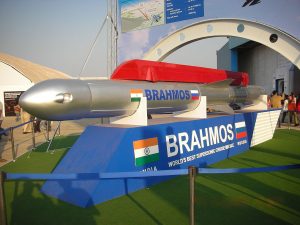The Philippines has officially become the first foreign nation to acquire the potent Indian-Russian BrahMos supersonic anti-ship missile, strengthening its navy’s ability to safeguard its sovereign claims in the South China Sea.
Today the Philippines Ministry of Defense announced that it had issued a notice of award on December 31 to BrahMos Aerospace Pvt Ltd, accepting its proposal to supply the shore-based anti-ship missile system for the price of $374 million.
The notice of award was issued shortly after after the Philippines’ budget department released initial funding for the armed forces’ “planned acquisition of shore-based anti-ship missile system and combat utility helicopters,” which was reported by the Philippine media earlier this month.
The Philippines has long expressed interest in purchasing the BrahMos weapons system, developed by BrahMos Aerospace, a joint venture between India and Russia that was set up in India in 1998. But Manila was forced to put its plans on hold after the COVID-19 pandemic cut deeply into its national budget.
The BrahMos is the world’s fastest supersonic cruise missile. It can be launched from submarines, ships, aircraft, or land platforms, and flies at nearly three times the speed of sound, making it nearly impossible for targets to evade.
The purchase of the BrahMos is a groundbreaking acquisition for the Armed Forces of the Philippines (AFP), which have frequently struggled to defend the country’s large maritime borders against Chinese incursions in regions of the South China Sea claimed by Manila. In particular, it will offer a measure of deterrence against any incursions by China’s multitudinous maritime militia and coast guard vessels.
As Collin Koh, a research fellow at the S. Rajaratnam School of International Studies at Singapore’s Nanyang Technological University, observed on Twitter, the Philippines has now joined a small club of Southeast Asian nations who possess a supersonic anti-ship cruise missile capability. Indonesia has operated the ship-based Russian-origin Yakhont supersonic anti-ship cruise missile since 2011; in 2015, Vietnam’s army also purchased from Russia two land-based Bastion-P mobile coastal defense missile systems.
But the purchase marks an important iteration in Asia’s naval arms competition, which has ratcheted up considerably since 2009, when China first began asserting its dubious “nine-dash line” maritime claim to most of the South China Sea. As Koh pointed out, the purchase also marked India’s advent as the second player in the Southeast Asian supersonic anti-ship missile game, alongside Russia. He wrote, the sale “heralds the eventual hurdling of initial policy difficulties in exporting the BrahMos,” suggesting that further sales may be on the horizon.
Thailand, Vietnam, and Indonesia have all shown interest in purchasing the BrahMos missile system. With Indian Defense Minister Rajnath Singh set to visit Vietnam later this month, a deal with Hanoi, whose increasingly robust ties with New Delhi now complement its historically warm relationship with Moscow, seems increasingly likely to eventuate at some stage.
The Philippines’ purchase is unlikely to be welcomed in Beijing, and it will be interesting to see how China responds to the news. But Chinese leaders should be under no illusions that this purchase hasn’t come as a direct response to their own pattern of assertiveness in the South China Sea. As long as China keeps up the pressure on its smaller Southeast Asian neighbors, it can expect other nations to follow the Philippines’ lead.

































